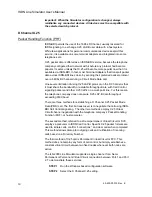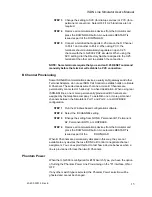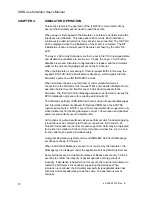
ISDN Line Simulator User’s Manual
40-400-00012, Rev. E
9
SAPI 63 addresses the
Signaling Access Controller
(SAC), which negotiates
and assigns the second packet address number, called a
Terminal Endpoint
Identifier
or TEI. The TEI is a unique number for each Terminating
Equipment on a particular line. For example, if a packet addressed to SAPI 0
and TEI 3 is sent to four ISDN devices connected to a single line, only the
Call Control function (SAPI 0) of the device assigned TEI 3 will acknowledge
and process the packet.
TEI Assignment
Most ISDN Terminating Equipment support a feature called automatic TEI
assignment. After a device is connected and synchronized, packets are
exchanged with the switch to establish the TEI. The switch knows which
TEI’s are assigned to that line and can query each device if in doubt. A
unique TEI between 64 and 126 is then formulated and returned to the
requesting device. TEI 127, the default broadcast TEI, is used for this
operation. Some switches or devices do not support automatic assignment,
however. The user is then responsible for configuring the device with a
unique
fixed TEI
between 1 and 63.
Layer 3 - Network Operation
Once packet exchange is established, the Network Layers of the switch and
Terminating Equipment can begin the Call Control dialog that replaces
conventional telephony signaling. The dialog is based on a set of commands
that operate on one or more parameters, similar to a computer Operating
System language. Commands are called
Messages
and parameters are
called
Information Elements
(IE). There are over 45 Messages and 65
Information Elements currently used by North American ISDN telephone
networks. Information elements may contain between one and over 100
bytes of constant or variable data.
For example, the SETUP Message initiates an incoming or outgoing call on
demand. Several Information Elements are contained in a SETUP Message,
and each are expected to be a particular value or variable type. The SETUP
Message usually contains the
Channel ID
,
Bearer Capability
, and
Calling
Party Number
Information Elements, among others. The Channel ID
determines which B or D Channel is used for the connection. The Bearer
Capability describes the call as voice, high-speed data, or packet mode data
and sets the data rate and other parameters. The Calling Party Number is
the caller’s Directory Number in ASCII code.
Other Messages and Information Elements enable tones, transport keypad
numbers, alert the called party, connect the call across the network, and
disconnect the call and release its resources when either party hangs up.
Standardized Message types and Information Elements are listed in Chapter
5. Call Control is extensible, however, and the number of Messages and
Information Elements continues to increase.
Multiple versions of ISDN Call Control currently exist. Two common ISDN
switches use proprietary Call Control: Northern Telecom’s DMS-100 series
Содержание ILS-C
Страница 1: ...ISDN Line Simulator ILS C User s Manual 40 400 00012 Rev E ...
Страница 8: ......
















































